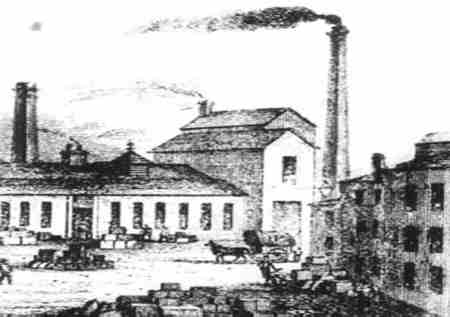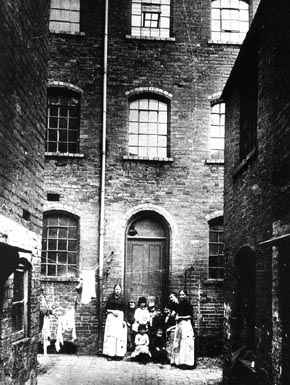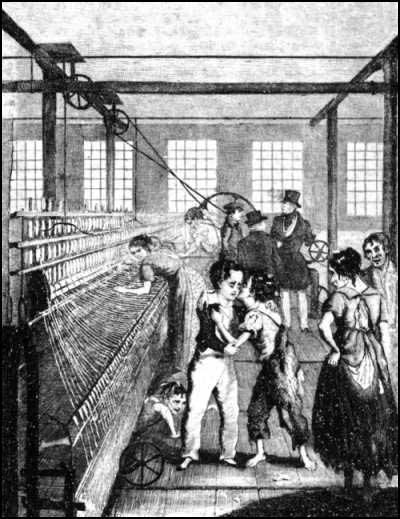
Child Labour & The Industrial Revolution

Child Labour & The Industrial Revolution
From Country to
Town
 As
the number of factories grew people from the countryside began to move
into the towns looking for better paid work. The wages of a farm worker
were very low and there were less jobs working on farms because of the
invention and use of new machines such as threshers. Also thousands of
new workers were needed to work machines in mills and foundries and the
factory owners built houses for them.Cities filled to overflowing and London
was particularly bad. At the start of the 19th Century about 1/5 of Britainís
population lived there, but by 1851 half the population of the country
had set up home in London. London, like most cities, was not prepared for
this great increase in people. People crowded into already crowded houses.
Rooms were rented to whole families or perhaps several families. If there
was no rooms to rent, people stayed in lodging houses.
As
the number of factories grew people from the countryside began to move
into the towns looking for better paid work. The wages of a farm worker
were very low and there were less jobs working on farms because of the
invention and use of new machines such as threshers. Also thousands of
new workers were needed to work machines in mills and foundries and the
factory owners built houses for them.Cities filled to overflowing and London
was particularly bad. At the start of the 19th Century about 1/5 of Britainís
population lived there, but by 1851 half the population of the country
had set up home in London. London, like most cities, was not prepared for
this great increase in people. People crowded into already crowded houses.
Rooms were rented to whole families or perhaps several families. If there
was no rooms to rent, people stayed in lodging houses.
Housing
 The
worker's houses were usually near to the factories so that people could
walk to work. They were built really quickly and cheaply. The houses were
cheap, most had between 2-4 rooms - one or two rooms downstairs, and one
or two rooms upstairs. Victorian families were big with 4 or 5 children.
There was no running water or toilet. A whole street would have to share
an outdoor pump and a couple of outside toilets. Most houses in the North
of England were "back to backs" (built in double rows) with no windows
at the front, no backyards and a sewer down the middle of the street. The
houses were built crammed close together, with very narrow streets between
them. Most of the houses were crowded with five or more people possibly
crammed into a single room. Even the cellars were full. Most of the
new towns were dirty and unhealthy. The household rubbish was thrown out
into the streets. Housing conditions like these were a perfect breeding
grounds for diseases. More than 31,000 people died during an outbreak of
cholera in 1832 and lots more were killed by typhus, smallpox and dysentery.
The
worker's houses were usually near to the factories so that people could
walk to work. They were built really quickly and cheaply. The houses were
cheap, most had between 2-4 rooms - one or two rooms downstairs, and one
or two rooms upstairs. Victorian families were big with 4 or 5 children.
There was no running water or toilet. A whole street would have to share
an outdoor pump and a couple of outside toilets. Most houses in the North
of England were "back to backs" (built in double rows) with no windows
at the front, no backyards and a sewer down the middle of the street. The
houses were built crammed close together, with very narrow streets between
them. Most of the houses were crowded with five or more people possibly
crammed into a single room. Even the cellars were full. Most of the
new towns were dirty and unhealthy. The household rubbish was thrown out
into the streets. Housing conditions like these were a perfect breeding
grounds for diseases. More than 31,000 people died during an outbreak of
cholera in 1832 and lots more were killed by typhus, smallpox and dysentery.
Pollution
Chimneys, bridges and
factory smoke blocked out most of the light in the towns. A layer of dirty
smoke often covered the streets like a blanket. This came from the factories
that used steam to power their machines. The steam was made by burning
coal to heat water. Burning coal produces a lot of dirty, black smoke.
Improvements
Gradually, improvements
for the poor were made. In 1848, Parliament passed laws that allowed city
councils to clean up the streets. One of the first cities to become a healthier
place was Birmingham. Proper sewers and drains were built. Land owners
had to build houses to a set standard. Streets were paved and lighting
was put up.
Over time slums were
knocked down and new houses built. However, these changes did not take
place overnight. When slums were knocked down in 1875 the poor people had
little choice but to move to another slum, making that one worse. Few could
afford new housing.
Child Labour
 Many
factory workers were children. They worked long hours and were often treated
badly by the supervisors or overseers. Sometimes the children started work
as young as four or five years old. A young child could not earn much,
but even a few pence would be enough to buy food.
Many
factory workers were children. They worked long hours and were often treated
badly by the supervisors or overseers. Sometimes the children started work
as young as four or five years old. A young child could not earn much,
but even a few pence would be enough to buy food.
Coal Mines
The coal mines were dangerous
places where roofs sometimes caved in, explosions happened and workers
got all sorts of injuries. There were very few safety rules. Cutting and
moving coal which machines do nowadays was done by men, women and children.
The
younger children often worked as "trappers" who worked trap doors.
They sat in a hole hollowed out for them and held a string which was fastened
to the door. When they heard the coal wagons coming they had to open the
door by pulling a string. This job was one of the easiest down the mine
but it was very lonely and the place were they sat was usually damp and
draughty.
Older
children might be employed as "coal bearers" carrying loads of coal
on their backs in big baskets.
The Mines Act was passed by the Government in 1842 forbidding the employment of women and girls and all boys under the age of teen down mines. Later it became illegal for a boy under 12 to work down a mine.
Mills
 While
thousands of children worked down the mine, thousands of others worked
in the cotton mills. The mill owners often took in orphans to their workhouses,
they lived at the mill and were worked as hard as possible. They spent
most of their working hours at the machines with little time for fresh
air or exercise. Even part of Sunday was spent cleaning machines. There
were some serious accidents, some children were scalped when their hair
was caught in the machine, hands were crushed and some children were killed
when they went to sleep and fell into the machine.
While
thousands of children worked down the mine, thousands of others worked
in the cotton mills. The mill owners often took in orphans to their workhouses,
they lived at the mill and were worked as hard as possible. They spent
most of their working hours at the machines with little time for fresh
air or exercise. Even part of Sunday was spent cleaning machines. There
were some serious accidents, some children were scalped when their hair
was caught in the machine, hands were crushed and some children were killed
when they went to sleep and fell into the machine.
Factories and Brick
Works
Children often worked
long and gruelling hours in factories and had to carry out some hazhardous
jobs. In match factories children were employed to dip matches into a chemical
called phosphorous. This phosphorous could cause their teeth to rot and
some died from the effect of breathing it into their lungs.
Chimney Sweeps
Although in 1832 the
use of boys for sweeping chimneys was forbidden by law, boys continued
to be forced through the narrow winding passages of chimneys in large houses.
When they first started at between five and ten years old, children suffered
many cuts, grazes and bruises on their knees, elbows and thighs however
after months of suffering their skin became hardened.
Street Children
Hordes of dirty, ragged
children roamed the streets with no regular money and no home to got to.
The children of the streets were often orphans with no-one to care for
them. They stole or picked pockets to buy food and slept in outhouses or
doorways. Charles Dickens wrote about these children in his book "Oliver
Twist".
Some
street children did jobs to earn money. They could work as crossing-sweepers,
sweeping a way through the mud and horse dung of the main paths to make
way for ladies and gentlemen. Others sold lace, flowers, matches or muffins
etc out in the streets.
Country Children
Poor families who lived
in the countryside were also forced to send their children out to work.
Seven and eight year olds could work as bird scarers,out in the fields
from four in the morning until seven at night. Older ones worked in gangs
as casual labourers.
Changes for the better
It took time for the
goverment to decide that working children ought to be protected by laws
as many people did not see anything wrong with the idea of children earning
their keep. They also believed that people should be left alone to help
themselves and not expect others to protect or keep them. They felt children
had a right to send their children out to work. People such as Lord Shaftesbury
and Sir Robert Peel worked hard to persuade the public that it was wrong
for children to suffer health problems and to miss out on schooling due
to work.